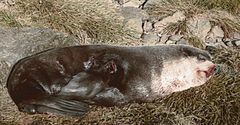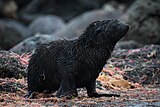Subantarctic fur seal
| Subantarctic fur seal | |
|---|---|

| |
| Male | |

| |
| Female | |
| Scientific classification | |
| Domain: | Eukaryota |
| Kingdom: | Animalia |
| Phylum: | Chordata |
| Class: | Mammalia |
| Order: | Carnivora |
| Clade: | Pinnipedia |
| Family: | Otariidae |
| Genus: | Arctocephalus |
| Species: | A. tropicalis
|
| Binomial name | |
| Arctocephalus tropicalis Gray, 1872
| |

| |
| Subantarctic fur seal range | |
| Synonyms | |
| |
The subantarctic fur seal (Arctocephalus tropicalis) is a species of arctocephaline found in the southern parts of the Indian, Pacific, and Atlantic Oceans.[3] It was first described by Gray in 1872 from a specimen recovered in northern Australia—hence the inappropriate specific name tropicalis.[4]
Description
The
Distribution

Subantarctic fur seals are geographically widespread. As their name implies, they generally breed in more northerly locations than the Antarctic fur seals. The largest breeding colonies are on Gough Island in the South Atlantic and Île Amsterdam in the southern part of the Indian Ocean. Breeding grounds are also found at Marion Island in the Prince Edward Islands (where an overlap with Antarctic fur seals occurs), the Crozet Islands, and Macquarie Island. Where grounds overlap, the subantarctic species can be identified by the orange colour on the chest. Hybridization is also known to occur between the two species in these areas.[7]
About 300,000 subantarctic fur seals are alive today, probably substantially down from when they were first discovered in 1810, as they were hunted for their pelts throughout the 19th century. Populations are recovering rapidly, though, in most areas whilst under the protection of the
Behavior
Breeding

As with other otariids, subantarctic fur seals gather in large rookeries on the shore to breed. They have a polygynous mating system in which dominant males will defend their harem of 6-20 females. Fights between males for mating rights are violent and can result in severe injuries. Apart from physically fighting, males will also compete against each other through vocalizations and threat displays.[9] The breeding season takes place from November to January. For females, gestation lasts around 51 weeks, at the end of which they will give birth to a single pup. 8–12 days after giving birth, they will breed again. Males are capable of mating at around 3–4 years of age, but they are unlikely to be able to hold a harem until they are 10–11 years old. Females reach sexual maturity at around 5 years.[10]
Life cycle

After being born, pups spend around 11 months feeding on their mother's milk, which contains around 39% fat. The length of their lactation period is typical of otariid seals, and contrasts with the far shorter 4 month lactation period of the Antarctic fur seal.[11] They stay at the rookery during this period. Weaning occurs shortly before the next offspring is born. They molt their black coat at around 3 months of age. As adults, they continue to molt their coat annually between March and May.[10][5]
Diet and foraging
Subantarctic fur seals hunt in shallow waters at night, when myctophid fish come close to the surface. They also feed on squid.[12] Other prey can include crustaceans, and occasionally rockhopper penguins and other seabirds.[13]
A study conducted on subantarctic fur seals at Marion Island from 1996 to 2000 concluded that Myctophid fish constituted the largest part of the seals' diet, with fish from the families Channichthyidae, Paralepididae, Nototheniidae, Microstomatidae and Notosudidae being eaten in smaller numbers. The size of prey fish ranged from small Myctophids with an average length of 25mm, to large Patagonian toothfish with an average length of 70 cm.[14]
Travelling

Subantarctic fur seals are unique in their tendency to occasionally travel very long distances from their home islands. Young males have been seen travelling thousands of miles from their native habitat, being sighted in countries such as Brazil, Angola, Australia and New Zealand.[15] In July 2015, a young male seal was caught and later released by local fishermen off the coast of Kenya, more than 4,000 miles (6.400 km) from its home. This is the furthest north that a subantarctic fur seal has been recorded travelling to.[16] Lactating females have been recorded travelling up to 530 km from their colonies in order to forage for food.[17]
Gallery
References
- . Retrieved 12 November 2021.
- ^ "Appendices | CITES". cites.org. Retrieved 2022-01-14.
- ^ "Subantarctic Fur Seals behaviour". The MarineBio Conservation Society. 18 May 2017. Retrieved 2021-05-07.
- ^ "ITIS - Standard Report Error". www.itis.gov.
- ^ a b c "Subantarctic Fur Seal".
- ISBN 9780128043271. Retrieved 2021-05-07.
- S2CID 837633.
- ^ "Subantarctic Fur Seal conservation status". Seal Conservation Society. Retrieved 2021-05-07.
- ^ "Arctocephalus tropicalis (Subantarctic fur seal)". Animal Diversity Web.
- ^ better source needed]
- S2CID 5932149.
- ^ "Subantarctic Fur Seal".
- ^ "Subantarctic Fur Seal - Facts, Diet, Habitat & Pictures on Animalia.bio".
- S2CID 253813200.
- ^ "Subantarctic Fur Seal". Ocean Connections. Retrieved 5 February 2024.
- ^ "This Fur Seal is 4,000 Miles from Home. Here's Why". 22 July 2015.
- ^ "Subantarctic Fur Seal".
Further reading
- Wynen, Louise P. et al. "Postsealing genetic variation and population structure of two species of fur seal (Arctocephalus gazella and A. tropicalis)". Molecular Ecology. Vol. 9. (2000). pp. 299–314.
- "Arctocephalus tropicalis". Integrated Taxonomic Information System. Retrieved 24 January 2006.
- Randall R. Reeves; Brent S. Stewart; Phillip J. Clapham; James A. Powell (2002). National Audubon Society Guide to Marine Mammals of the World. Alfred A. Knopf, Inc. ISBN 0-375-41141-0.

















